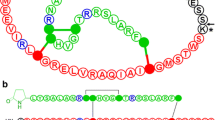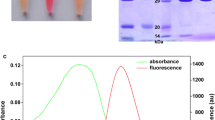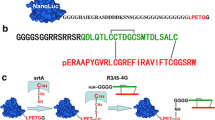Abstract
Relaxin-3 (also known as INSL7) is a recently identified neuropeptide belonging to the insulin/relaxin superfamily. It has putative roles in the regulation of stress responses, food intake, and reproduction by activation of its cognate G-protein-coupled receptor RXFP3. It also binds and activates the relaxin family peptide receptors RXFP1 and RXFP4 in vitro. To obtain a europium-labeled relaxin-3 as tracer for studying the interaction of these receptors with various ligands, in the present work we propose a novel site-specific labeling strategy for the recombinant human relaxin-3 that has been previously prepared in our laboratory. First, the N-terminal 6×His-tag of the single-chain relaxin-3 precursor was removed by Aeromonas aminopeptidase and all of the primary amines of the resultant peptide were reversibly blocked by citroconic anhydride. Second, the A-chain N-terminus of the blocked peptide was released by endoproteinase Asp-N cleavage that removed the linker peptide between the B- and A-chains. Third, an alkyne moiety was introduced to the newly released A-chain N-terminus by reaction with the highly active primary amine-specific N-hydroxysuccinimide ester. Fourth, after removal of the reversible blockage under mild acidic condition, europium-loaded DOTA with an azide moiety was introduced to the two-chain relaxin-3 carrying the alkyne moiety through click chemistry. Using this site-specific labeling strategy, homogeneous monoeuropium-labeled human relaxin-3 could be obtained with good overall yield. In contrast, conventional random labeling resulted in a complex mixture that was poorly resolved because human relaxin-3 has four primary amine moieties that all react with the modification reagent. Both saturation and competition binding assays demonstrated that the DOTA/Eu3+-labeled relaxin-3 retained high binding affinity for human RXFP3, RXFP4, and RXFP1 and was therefore a suitable non-radioactive and stable tracer to study the interaction of various natural or designed ligands with these receptors. Using this site-specific labeling strategy, other functional probes, such as fluorescent dyes, biotin, or nanoparticles could also be introduced to the A-chain N-terminal of the recombinant human relaxin-3. Additionally, we improved the time-resolved fluorescence assay for the DOTA-bound europium ion which paves the way for the use of DOTA as a lanthanide chelator for protein and peptide labeling in future studies.







Similar content being viewed by others
Abbreviations
- BSA:
-
Bovine serum albumin
- DOTA:
-
1,4,7,10-tetraazacyclododecane-1,4,7,10-tetraacetic acid
- DMSO:
-
Dimethyl sulfoxide
- HPLC:
-
High performance liquid chromatography
- NHS:
-
N-hydroxysuccinimide
- PCR:
-
Polymerase chain reaction
- PEG:
-
Polyethylene glycol
- TBTA:
-
Tris[(1-benzyl-1H-1,2,3-triazol-4-yl)methyl]amine
- t-BuOH:
-
tert-Butyl alcohol
- TFA:
-
Trifluoroacetic acid
- TRF:
-
Time-resolved fluorescence
- UV:
-
Ultra-violet
References
Banerjee A, Shen PJ, Ma S, Bathgate RA, Gundlach AL (2010) Swim stress excitation of nucleus incertus and rapid induction of relaxin-3 expression via CRF1 activation. Neuropharmacology 58:145–155
Bathgate RA, Samuel CS, Burazin TC, Layfield S, Claasz AA, Reytomas IG, Dawson NF, Zhao C, Bond C, Summers RJ, Parry LJ, Wade JD, Tregear GW (2002) Human relaxin gene 3 (H3) and the equivalent mouse relaxin (M3) gene: novel members of the relaxin peptide family. J Biol Chem 277:1148–1157
Burazin TC, Bathgate RA, Macris M, Layfield S, Gundlach AL, Tregear GW (2002) Restricted, but abundant, expression of the novel rat gene-3 (R3) relaxin in the dorsal tegmental region of brain. J Neurochem 82:1553–1557
De Silva CR, Vagner J, Lynch R, Gillies RJ, Hruby VJ (2010) Optimization of time-resolved fluorescence assay for detection of Eu-DOTA-labeled ligand-receptor interactions. Anal Biochem 398:15–23
Hida T, Takahashi E, Shikata K, Hirohashi T, Sawai T, Seiki T, Tanaka H, Kawai T, Ito O, Arai T, Yokoi A, Hirakawa T, Ogura H, Nagasu T, Miyamoto N, Kuromitsu J (2006) Chronic intracerebroventricular administration of relaxin-3 increases body weight in rats. J Recept Signal Transduct Res 26:147–158
Hsu SY, Nakabayashi K, Nishi S, Kumagai J, Kudo M, Sherwood OD, Hsueh AJ (2002) Activation of orphan receptors by the hormone relaxin. Science 295:671–674
Kolb HC, Finn MG, Sharpless KB (2001) Click chemistry: diverse chemical function from a few good reactions. Angew Chem Int Ed Engl 40:2004–2021
Liu C, Chen J, Sutton S, Roland B, Kuei C, Farmer N, Sillard R, Lovenberg TW (2003a) Identification of relaxin-3/INSL7 as a ligand for GPCR142. J Biol Chem 278:50765–50770
Liu C, Eriste E, Sutton S, Chen J, Roland B, Kuei C, Farmer N, Jörnvall H, Sillard R, Lovenberg TW (2003b) Identification of relaxin-3/INSL7 as an endogenous ligand for the orphan G-protein-coupled receptor GPCR135. J Biol Chem 278:50754–50764
Liu C, Kuei C, Sutton S, Chen J, Bonaventure P, Wu J, Nepomuceno D, Kamme F, Tran DF, Zhu J, Wilkinson T, Bathgate R, Eriste E, Sillard R, Lovenberg TW (2005) INSL5 is a high affinity specific agonist for GPCR142 (GPR100). J Biol Chem 280:292–300
Luo X, Liu YL, Layfield S, Shao XX, Bathgate RA, Wade JD, Guo ZY (2010) A simple approach for the preparation of mature human relaxin-3. Peptides 31:2083–2088
Ma S, Sang Q, Lanciego JL, Gundlach AL (2009) Localization of relaxin-3 in brain of Macaca fascicularis: identification of a nucleus incertus in primate. J Comp Neurol 517:856–872
McGowan BM, Stanley SA, Smith KL, White NE, Connolly MM, Thompson EL, Gardiner JV, Murphy KG, Ghatei MA, Bloom SR (2005) Central relaxin-3 administration causes hyperphagia in male Wistar rats. Endocrinology 146:3295–3300
McGowan BM, Stanley SA, Smith KL, Minnion JS, Donovan J, Thompson EL, Patterson M, Connolly MM, Abbott CR, Small CJ, Gardiner JV, Ghatei MA, Bloom SR (2006) Effects of acute and chronic relaxin-3 on food intake and energy expenditure in rats. Regul Pept 136:72–77
McGowan BM, Stanley SA, White NE, Spangeus A, Patterson M, Thompson EL, Smith KL, Donovan J, Gardiner JV, Ghatei MA, Bloom SR (2007) Hypothalamic mapping of orexigenic action and Fos-like immunoreactivity following relaxin-3 administration in male Wistar rats. Am J Physiol Endocrinol Metab 292:E913–E919
McGowan BM, Stanley SA, Donovan J, Thompson EL, Patterson M, Semjonous NM, Gardiner JV, Murphy KG, Ghatei MA, Bloom SR (2008) Relaxin-3 stimulates the hypothalamic-pituitary-gonadal axis. Am J Physiol Endocrinol Metab 295:E278–E286
Rosengren KJ, Lin F, Bathgate RA, Tregear GW, Daly NL, Wade JD, Craik DJ (2006) Solution structure and novel insights into the determinants of the receptor specificity of human relaxin-3. J Biol Chem 281:5845–5851
Selvin PR (2002) Principles and biophysical applications of lanthanide-based probes. Annu Rev Biophys Biomol Struct 31:275–302
Shabanpoor F, Hughes RA, Bathgate RA, Zhang S, Scanlon DB, Lin F, Hossain MA, Separovic F, Wade JD (2008) Solid-Phase synthesis of europium-labeled human INSL3 as a novel probe for the study of ligand-receptor interactions. Bioconjugate Chem 19:1456–1463
Shabanpoor F, Separovic F, Wade JD (2009) The human insulin superfamily of polypeptide hormones. Vitam Horm 80:1–31
Silvertown JD, Neschadim A, Liu HN, Shannon P, Walia JS, Kao JC, Robertson J, Summerlee AJ, Medin JA (2010) Relaxin-3 and receptors in the human and rhesus brain and reproductive tissues. Regul Pept 159:44–53
Smith CM, Lawrence AJ, Sutton SW, Gundlach AL (2009a) Behavioral phenotyping of mixed background (129S5:B6) relaxin-3 knockout mice. Ann N Y Acad Sci 1160:236–241
Smith CM, Shen PJ, Ma S, Sutton SW, Gundlach AL (2009b) Verification of a relaxin-3 knockout/LacZ reporter mouse as a model of relaxin-3 deficiency. Ann N Y Acad Sci 1160:259–260
Smith CM, Hosken IT, Sutton SW, Lawrence AJ, Gundlach AL (2011a) Relaxin-3 null mutation mice display a circadian hypoactivity phenotype. Genes Brain Behav. doi:10.1111/j.1601-183X.2011.00730.x (published online)
Smith CM, Ryan PJ, Hosken IT, Ma S, Gundlach AL (2011b) Relaxin-3 systems in the brain-The first 10 years. J Chem Neuroanat. (published online)
Sudo S, Kumagai J, Nishi S, Layfield S, Ferraro T, Bathgate RA, Hsueh AJ (2003) H3 relaxin is a specific ligand for LGR7 and activates the receptor by interacting with both the ectodomain and the exoloop 2. J Biol Chem 278:7855–7862
Tanaka M (2010) Relaxin-3/insulin-like peptide 7, a neuropeptide involved in the stress response and food intake. FEBS J 277:4990–4997
Tanaka M, Iijima N, Miyamoto Y, Fukusumi S, Itoh Y, Ozawa H, Ibata Y (2005) Neurons expressing relaxin 3/INSL 7 in the nucleus incertus respond to stress. Eur J Neurosci 21:1659–1670
Watanabe Y, Miyamoto Y, Matsuda T, Tanaka M (2011a) Relaxin-3/INSL7 regulates the stress-response system in the rat hypothalamus. J Mol Neurosci 43:169–174
Watanabe Y, Tsujimura A, Takao K, Nishi K, Ito Y, Yasuhara Y, Nakatomi Y, Yokoyama C, Fukui K, Miyakawa T, Tanaka M (2011b) Relaxin-3-deficient mice showed slight alteration in anxiety-related behavior. Front Behav Neurosci 5:50
Acknowledgments
This work was supported by the National Natural Science Foundation of China (30970609) and the National Basic Research Program of China (973 Program, no. 2010CB912604). Part of this research was funded by NHMRC (Australia) project Grants 350284, 508995 to JDW and RADB. We are grateful to Tania Ferraro & Sharon Layfield for assistance with biochemical assays. The studies at the FNI were supported by the Victorian Government’s Operational Infrastructure Support Program.
Author information
Authors and Affiliations
Corresponding authors
Additional information
W.–J. Zhang and X. Luo contributed equally to this work.
Rights and permissions
About this article
Cite this article
Zhang, WJ., Luo, X., Liu, YL. et al. Site-specific DOTA/europium-labeling of recombinant human relaxin-3 for receptor-ligand interaction studies. Amino Acids 43, 983–992 (2012). https://doi.org/10.1007/s00726-011-1164-z
Received:
Accepted:
Published:
Issue Date:
DOI: https://doi.org/10.1007/s00726-011-1164-z




